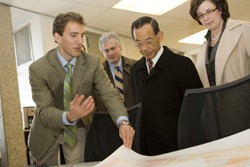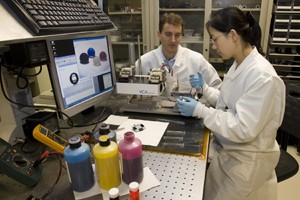Further action is required to make this featured image accessible
The below criteria must be satisfied:
- Add featured-image alt tag (in page properties OR on image metadata in the dam)
The image will not display until the issue above is resolved.
Make Brighter, Full-Color Electronic Readers? Brilliant!
For the first time e-paper will achieve the brilliance of printed media, as described in the May issue of "Nature Photonics."
Thinking about getting an e-reader but not sure if you like reading the dim screen? An international collaboration of the University of Cincinnati, Sun Chemical, Polymer Vision and Gamma Dynamics has announced Electrofluidic Display Technology (EFD), the first technology to electrically switch the appearance of pigments in a manner that provides visual brilliance equal to conventional printed media.
This new entry into the race for full-color electronic paper can potentially provide better than 85 percent white-state reflectance, a performance level required for consumers to accept reflective display applications such as e-books, cell-phones and signage.
If you compare this technology to whats been developed previously, theres no comparison, says developer Jason Heikenfeld, assistant professor of electrical engineering in UCs College of Engineering and director of the Novel Devices Laboratory at UC. Were ahead by a wide margin in critical categories such as brightness, color saturation and video speed.

Jason Heikenfeld, Russell Schwartz, DIC's Koji Oe and Sun's Cynthia Arnold.
This work, which has been underway for several years, has just been published in the paper
Electrofluidic displays using YoungLaplace transposition of brilliant pigment dispersions.
Lead author Heikenfeld explains the primary advantage of the approach.
The ultimate reflective display would simply place the best colorants used by the printing industry directly beneath the front viewing substrate of a display, he says. In our EFD pixels, we are able to hide or reveal colored pigment in a manner that is optically superior to the techniques used in electrowetting, electrophoretic and electrochromic displays.
Because the optically active layer can be less than 15 microns thick, project partners at PolymerVision see strong potential for rollable displays. The product offerings could be extremely diverse, including electronic windows and tunable color casings on portable electronics.

Jason Heikenfeld with student Linlin Hou, doctoral candidate.
Furthermore, because three project partners are located in Cincinnati (UC, Sun Chemical, Gamma Dynamics), technology commercialization could lead to creation of numerous high-tech jobs in southwest Ohio.
To expedite commercialization, a new company has been launched: Gamma Dynamics with founding members of this company being John Rudolph as president (formerly of Corning), Kenneth Dean as CTO (of Northwestern University), and Heikenfeld as principal scientist.
This takes the Amazon Kindle, for example, which is black and white, and could make it full color, Heikenfeld says. So now you could take it from a niche product to a mainstream product.
Funding for this work was provided by Sun Chemical, PolymerVision, the National Science Foundation and the Air Force Research Laboratory.
Other news about Jason Heikenfeld and the Department of Electrical and Computer Engineering

Jason Heikenfeld
Signs of Things to Come in Display Technology
In
the home of the history of signs, the University of Cincinnati and
Transitions Digital Graphics unveiled the future of sign technology.
Dynamic See-Through Display Technology Sheds Light on Sign Industry
UC
and Transitions Digital Graphics introduce a novel transparent and
emissive signage technology/product, a major innovation and entirely
new medium for architectural design.
Statehouse Showcase: UC Displays Research Aimed at Helping Ohios Economy
State leaders took a hands-on approach to learning about UC research during a Feb. 18 showcase of university projects that have already proven or hold strong promise for helping Ohios economy.
Listen to Jason Heikenfeld's Interview with WVXU's Ann Thompson on Focus on Technology
Related Stories
President Pinto announces interim provost
April 8, 2025
UC President Neville Pinto announced that Dr. John Weidner, dean of the College of Engineering and Applied Science, will step in as interim provost following Dr. Kristi Nelson's departure on June 1.
OTR mural celebrates UC alumni success
April 4, 2025
The UC Alumni Association, UCAA, will mark its annual Alumni Celebration during its upcoming Alumni Week, April 7-13, with a community art project commemorating this year’s slate of alumni honorees receiving the organization’s top awards.
UC students combine engineering and design experience
April 3, 2025
At the University of Cincinnati, the College of Design, Art, Architecture and Planning hosted a design competition with HAAG-Streit USA, where students were tasked with designing an ophthalmology workstation that is accessible and able to be incorporated into retail settings. Caleb Loayza, a mechanical engineering student at the College of Engineering and Applied Science, and Guy Mueller, an industrial design student, combined their expertise and took home first place.
